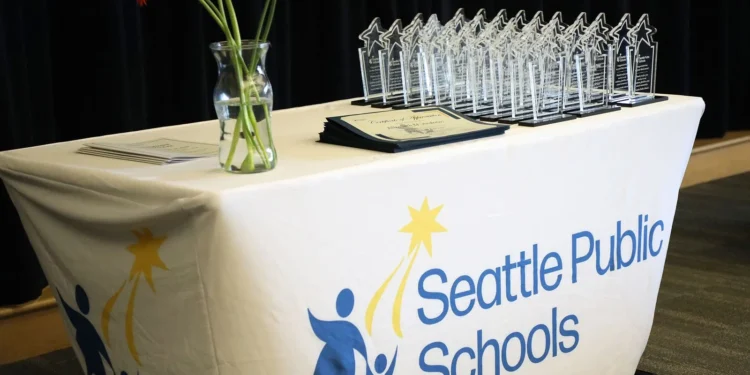Families will discover next week who may become the next leader of Seattle Public Schools.
The public is expected to learn the new superintendent’s identity on November 5 at the meeting where the school board will conduct a roll call vote on their selection, then vote on proceeding with contract negotiations.
Board Director Liza Rankin acknowledged at an October 29 meeting that this has been an “unorthodox” interview process, one kept largely confidential.
The remaining two candidates’ names had not been released as of the meeting when the board agreed on who they believe is the stronger finalist with a history of leadership roles in education.
“We conducted final interviews with those two candidates, and they shared with us their 100-day plan,” SPS Board President Gina Topp explained. The original pool of 41 candidates originated from a nationwide search. From there, the board interviewed eight candidates and conducted a final round of interviews for two finalists on October 22.
Board directors agreed to advance with one finalist they identified only as Candidate 7.
The process has remained confidential. “This approach allowed us to build a diverse and highly-qualified pool,” Topp added. “We’re seeking someone with experience: a clear voice, a commitment to equity, and the courage to lead with vision and accountability.”
This occurs as the district confronts numerous changes. The incoming superintendent could soon work with a new majority school board as four of seven seats face election in November. Board Director Joe Mizrahi stated the new district leader needs financial and operational expertise to address the budget crisis and lead with authenticity.
“I think this candidate speaks with a blunt nature that will be very helpful for us, and I think the clarity will be very refreshing for our district,” Mizrahi explained.
“I believe that candidate will bring our district as close as possible to where we need to be for not only my son, but so many children that are being born right now,” Director Brandon Hersey stated about his newborn’s future in Seattle Public Schools. “We should feel the fire up under us to get this figured out, because we want to provide the best educational, world-class experience for our students as possible so we can maintain a level of enrollment necessary to maintain that.”
The Seattle Education Association and the Principals’ Association of Seattle Schools labor unions provided questions for the closed-door interviews, then made a recommendation based on the answers.
“We’re the biggest district in the state, and it has a huge impact on the lives of our entire community, so that’s a big responsibility,” SEA President Girard Montejo-Thompson stated. “We’re definitely looking for someone who recognizes that and is prepared to take it on.”
While no community engagement occurred during candidate interviews, the board stated it used a leadership profile to guide its search. That profile was based on input from focus groups, a district-wide survey, and community sessions. Some parents indicate they’re placing faith in this board to fill this role.
“We have seen long-standing leaders within the district who are unwilling to respond to big needs like student safety and academic achievement, and it’s time for real accountability of those staff members and the system as a whole,” SPS parent Erin MacDougall stated.
The board will vote November 5 on whether to offer Candidate 7 an employment agreement and has invited that person to attend when they reveal the individual’s identity.
The November 5 announcement timing coinciding with Election Day creating unusual circumstance where superintendent selection occurs simultaneously with school board elections potentially reshaping the governing body, with the convergence raising questions about whether the incoming leader will work with the board that hired them or a newly constituted majority with different priorities.
The “unorthodox” interview process characterization by Board Director Liza Rankin acknowledging the confidentiality approach deviates from typical public sector hiring practices, with the admission suggesting board members recognize the secretive process may generate criticism from transparency advocates and community members expecting public participation.
The unreleased candidate names as of the October 29 decision meeting demonstrating the board’s commitment to confidentiality throughout the selection process, with the anonymity protecting finalists’ current employment while potentially preventing public scrutiny that could reveal concerning background information or problematic past performance.
The Candidate 7 designation representing the board’s internal tracking system for anonymous applicants, with the numerical identifier preserving secrecy while enabling board discussion about specific individuals without revealing identities that could compromise their current positions or trigger premature public debate.
The 100-day plan presentations from both finalists indicating the board requested specific implementation strategies rather than general vision statements, with the requirement demonstrating that directors want actionable plans addressing immediate district challenges rather than abstract leadership philosophies.
The 41-candidate nationwide search pool suggesting substantial interest in the Seattle superintendent position despite the district’s well-publicized challenges, with the applicant volume potentially reflecting either the role’s prestige as Washington’s largest school district or generous compensation packages attractive to education administrators nationwide.
The eight semifinalist interviews representing substantial board time commitment reviewing nearly 20% of the original applicant pool, with the extended vetting process suggesting directors took seriously their responsibility selecting leadership for a district serving approximately 50,000 students across 104 schools.
The October 22 final interviews providing nearly two weeks for board deliberation before the October 29 decision, with the compressed timeline potentially reflecting either strong consensus around Candidate 7 or urgency to fill the position before the November 5 board composition potentially changes.
Board President Gina Topp’s justification that confidentiality “allowed us to build a diverse and highly-qualified pool” suggesting public processes deter strong candidates, with the argument implying that sitting superintendents and administrators won’t apply if their current employers learn they’re seeking other positions.
The emphasis on “experience, clear voice, commitment to equity, and courage to lead with vision and accountability” articulating the leadership qualities the board prioritized, with the criteria reflecting Seattle’s progressive values while acknowledging the district needs decisive leadership capable of making difficult decisions amid budget constraints.
The four of seven school board seats facing November election creating potential governance instability where the incoming superintendent might immediately confront a board majority opposed to their selection, with the timing raising questions about whether lame-duck directors should make such consequential hiring decisions.
Director Joe Mizrahi’s emphasis on “financial and operational expertise” reflecting the district’s severe budget crisis requiring approximately $100 million in cuts, with the qualification prioritizing fiscal management over purely educational leadership experience that previous superintendents emphasized.
The “blunt nature” and “clarity” qualities Mizrahi praised in Candidate 7 suggesting the board selected a direct communicator willing to deliver uncomfortable truths, with the characterization potentially indicating frustration with previous leadership’s diplomatic approach that avoided difficult conversations about district performance.
Director Brandon Hersey’s profanity-laced statement that “we should feel the fire up under us to get this figured out” demonstrating the urgency board members feel about district challenges, with the unguarded language reflecting frustration about enrollment declines and academic performance that threaten Seattle Public Schools’ viability.
Hersey’s reference to his newborn son’s future in the district personalizing the superintendent selection beyond abstract governance, with the statement illustrating how board members’ own children’s educational prospects depend on successful leadership that can reverse negative trends.
The enrollment maintenance emphasis acknowledging that declining student numbers create fiscal death spiral where fewer students mean reduced state funding requiring budget cuts that diminish program quality driving further enrollment losses, with the cycle threatening the district’s financial sustainability.
The Seattle Education Association and Principals’ Association labor unions providing interview questions and making recommendations representing unusual union involvement in superintendent selection, with the participation reflecting organized labor’s substantial influence in Seattle politics and recognition that the new leader’s approach to collective bargaining will affect thousands of members.
SEA President Girard Montejo-Thompson’s statement about the district’s “huge impact on the lives of our entire community” emphasizing public education’s role beyond individual student outcomes, with the framing positioning the superintendent search as consequential for Seattle’s broader civic health and economic prosperity.
The absence of community engagement during candidate interviews representing significant departure from participatory processes typical in public sector hiring, with the exclusion potentially generating backlash from parents and activists who believe they deserve input selecting leadership for their children’s schools.







